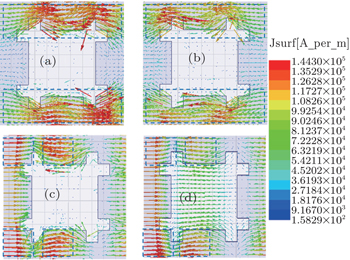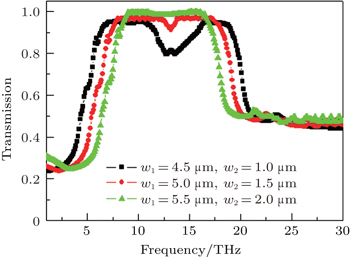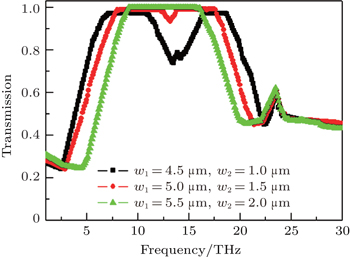† Corresponding author. E-mail:
Project supported by the Doctorate Scientific Research Foundation of Hezhou University, China (Grant No. HZUBS201503), the Promotion of the Basic Ability of Young and Middle-aged Teachers in Universities Project of Guangxi Zhuang Autonomous Region, China (Grant No. KY2016YB453), the Guangxi Colleges and Universities Key Laboratory Symbolic Computation, China, Engineering Data Processing and Mathematical Support Autonomous Discipline Project of Hezhou University, China (Grant No. 2016HZXYSX01).
In this paper, we present the design, simulation, and experimental verification of a dual-band free-standing metamaterial filter operating in a frequency range of 1 THz–30 THz. The proposed structure consists of periodically arranged composite air holes, and exhibits two broad and flat transmission bands. To clarify the effects of the structural parameters on both resonant transmission bands, three sets of experiments are performed. The first resonant transmission band shows a shift towards higher frequency when the side width w1 of the main air hole is increased. In contrast, the second resonant transmission band displays a shift towards lower frequency when the side width w2 of the sub-holes is increased, while the first resonant transmission band is unchanged. The measured results indicate that these resonant bands can be modulated individually by simply optimizing the relevant structural parameters (w1 or w2) for the required band. In addition, these resonant bands merge into a single resonant band with a bandwidth of 7.7 THz when w1 and w2 are optimized simultaneously. The structure proposed in this paper adopts different resonant mechanisms for transmission at different frequencies and thus offers a method to achieve a dual-band and low-loss filter.
In recent years, artificially prepared metamaterial devices have demonstrated unique electromagnetic properties that originate from the coupled interaction between electromagnetic waves and designed periodic arrays of sub-wavelength air holes.[1–5] Of these designed metamaterial structures, self-symmetric metal/dielectric/metal composite multilayer nanostructures have been studied most widely, both numerically and experimentally.[6–10] This is because this configuration offers enormous modulation flexibility over the effective medium parameters (including the effective permeability, effective permittivity and effective impedance). In particular, composite multilayer fishnet nanostructures are experimentally demonstrated at optical and infrared wavelengths through patterning nano-scale air holes in composite multilayer stacks, which are subsequently deposited on different types of substrates by reactive ion etching (RIE), focused ion beam (FIB) etching, or metal lift-off techniques.[11–13] Many experiments have been carried out based on substrate-mounted hollow fishnet composite multilayer nanostructures with non-ideal tapered sidewalls. Measured results proved the existence of the asymmetric reflections, which must be measured from the opposing interfaces of the designed device because of the occurrence of nonzero magneto-electric coupling.[14] Unfortunately, the supporting substrate and the sidewall angle induced in the fabrication process[15–19] may result in the undesirable broken symmetry in the metamaterial device. This broken symmetry damages the effective medium model because the electric and magnetic polarizations of the model are characterized based on the electric and magnetic field components. It is therefore necessary to develop a metamaterial device that does not require substrate supporting. Moreover, the unique optical properties of the designed metamaterial device are dependent on the specific structural design, which is aligned using the periodic lattice.[20] The optical properties of the designed structure are related to the effective permeability and permittivity, which in turn are strongly dependent on the resonant frequency. This optically dispersive behavior always results in the distortion of the electromagnetic signal and narrow operable bandwidth,[21–24] which naturally restricts the widespread applications of the designed metamaterial device in practice. Therefore, a new nanostructure with non-substrate supporting should be developed to tailor the dispersive behavior of the structure and obtain both low loss and broad bandwidth characteristics, which still satisfy the strict constraints of the nanofabrication approach.
In this paper, we present the numerical and experimental verification of an optically functional metamaterial filter in a three-layer metal–dielectric free-standing configuration that is optimized to produce dual-band properties in a 1 THz–30 THz wave spectral window, and highly reflective behavior outside these bands. This non-hollow fishnet structure shapes the resonant dispersion behaviors of the effective permeability and effective permittivity to satisfy the dual- and flat-band transmission demands. These effective parameters are extracted from the measured transmission and reveal magnetic–electric coupling in these plasmonic resonant bands. The measured transmission of the proposed free-standing structure agrees well with the simulated result, which confirms that this non-hollow fishnet structure can be produced for dual-band metamaterial filter applications. In addition, these resonant bands can be modulated individually. This useful structural design overcomes the limitations of narrow bandwidths, which can thus distinctly increase the available possibilities for practical optical device manufacture.
The proposed structure is composed of a metal/dielectric stack with a compound square air hole array that perforates all silver layers as shown in Fig.
To validate the proposed design, the dual-band metamaterial filter is fabricated by the following procedure: a 0.04-μm-thick bottom silver layer is evaporated on a thermally oxidized Si handle substrate at a rate of 1.8 Å·s−1 by electron beam evaporation (ZZL-U400H). A 0.18-μm-thick polyimide layer is deposited on the bottom silver layer by spin-coating a polyimide precursor at a speed of 1950 rpm for 28 s (HD Microsystem PI2556). The polyimide layer is imidized by heating at 135 °C for 38 min and then at 220 °C for 70 min by using a nitrogen-purged convection oven. A 0.18-μm-thick SU-8 layer is then spun on the polyimide layer (MSC-400Bz-6N). The SU-8 layer is baked at 100 °C for 75 s (C-MAG HP10). Another 0.04-μm-thick top silver layer is evaporated on the intermediate dielectric layer. The fabricated metal/dielectric structure is subsequently removed from the substrate by using a buffered oxide etchant to etch the underlying thermal oxide away. The designed main and nano-notch air hole array is patterned on the top and bottom silver layers using a focused ion beam system[25] (Helios nanolab 600). The measured transmission of the designed structure is achieved (Bruker Optics Equinox 55 Fourier transform infrared spectrometer), and the optical microscopy image of the free-standing dual-band metamaterial filter is obtained (Leica DM4M) as shown in Fig.
The optical properties of the proposed structure can be understood through examining the effective medium parameters as shown in Fig.





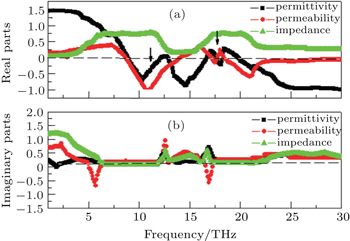 | Fig. 2. Simulated (a) real and (b) imaginary parts of effective medium parameters (permittivity, permeability, and impedance) versus frequency. |
To investigate the electromagnetic responses of these transmission bands, the current distributions on the top and bottom layers of the designed structure are calculated, and the results are shown in Fig.
Clearly, the proposed structure shows nearly equal calculated current distributions on the bottom and top silver layers in the first band, and this indicates that neither magnetic nor electric dipole moments are excited by the electric/magnetic fields. The calculated current distributions for the first magnetic resonant mode generate charge accumulation, directional flow, and depletion in an elongated region (dotted line areas) along the edges of the main air hole area of the unit cell as shown in Figs.
To assess the effects of the structural parameters on the transmission bands, three set of experiments are carried out: the first set is for varying air hole width (w1) with sub-hole width (w2) fixed, the second set is for varying w2 with w1 fixed, and the third set is for varying w1 and w2 simultaneously.
In the proposed structure, the structural parameters w1 and w2 can naturally affect the optical properties. To obtain an optimized dual-band structural design, the effects of these factors are experimentally investigated. In the first set of experiments as shown in Fig.
 | Fig. 4. Measured transmission spectra of the designed structure for different values of w1 (w2 = 1 μm). |
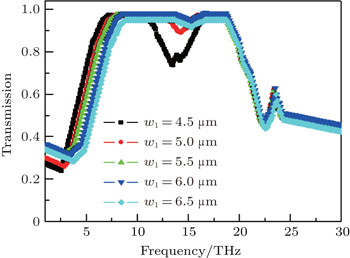 | Fig. 5. Simulated transmission spectra of the designed structure for different values of w1 (w2 = 1 μm). |
The second set of experiments is carried out in a similar manner as shown in Fig.
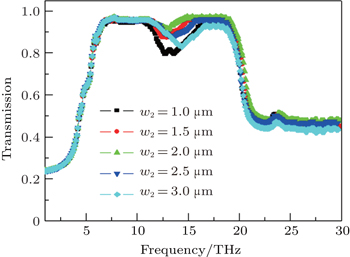 | Fig. 6. Measured transmission spectra of the designed structure with w1 = 4.5 μm for different values of w2. |
The third set of experiments is carried out by simultaneously increasing both structural parameters (w1, w2) to demonstrate the effects of these parameters on the resonant bands of the designed filter.
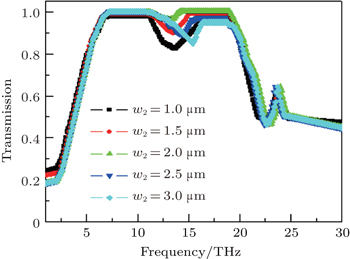 | Fig. 7. Simulated transmission spectra of the designed structure with w1 = 4.5 μm for different values of w2. |
Figure
In this work, we experimentally study a dual-band metamaterial filter. The first resonant band is expanded and shifts to higher frequency by increasing w1 alone. The second resonant band is expanded and shifts to lower frequency by increasing w2 alone. Further experimental studies indicate that the first and second band can be modulated to move closer to each other together and merge into a single transmission band by simultaneously optimizing the two structural parameters. This experimental demonstration verifies that the proposed free-standing non-hollow fishnet structure can be used to produce a new metamaterial filter with dual-band properties.
| 1 | |
| 2 | |
| 3 | |
| 4 | |
| 5 | |
| 6 | |
| 7 | |
| 8 | |
| 9 | |
| 10 | |
| 11 | |
| 12 | |
| 13 | |
| 14 | |
| 15 | |
| 16 | |
| 17 | |
| 18 | |
| 19 | |
| 20 | |
| 21 | |
| 22 | |
| 23 | |
| 24 | |
| 25 | |
| 26 | |
| 27 | |
| 28 | |
| 29 | |
| 30 | |
| 31 | |
| 32 |




